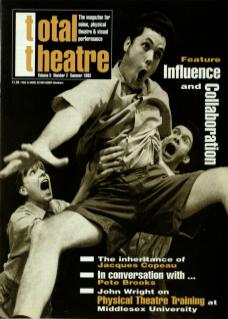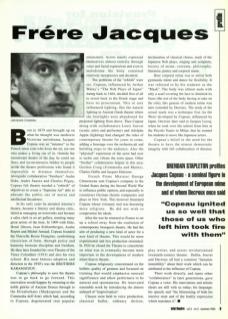Born in 1879 and brought up on what he thought was mediocre Victorian melodrama, Jacques Copeau was an ‘amateur’ in the French sense (one who loves the art, not one who makes a living out of it). Outside the mainstream theatre of the day, he could see flaws and inconsistencies hidden to people inside the theatre professions who found it impossible to distance themselves. Alongside collaborative ‘brothers’ Audre Gide, Audre Saures and Charles Peguy, Copeau felt theatre needed a ‘rebirth’ of objectives to create a ‘Supreme Art’ able to educate the public out of moral and intellectual decadence.
In his early years he attended Antoine's theatre, became a literary and drama critic, failed at managing an ironworks, and became a sales clerk in an art gallery, meeting many great artists of the time. In 1909 with Gide, Henri Gheon, Jean Schlumberger, Audre Ruyter and Michel Arnaud, Copeau founded the Nouvelle Revue Française, symbolising classicism of form, through purity and harmony between discipline and freedom. He then later founded his own Theatre of the Vieux Columbier (1913) and also his own school. His most famous adaption and direction in the 1930s was The Brothers Karamazov.
Copeau's philosophy to save the theatre was to go back to go forward. This renovation would happen by returning to the noble glories of Ancient Greece through to the Elizabethans (Shakespeare and the Commedia dell'Arte) which had, according to Copeau, degenerated into popular amusement. Actors mainly expressed themselves almost entirely through voice and facial expressions and even in melodrama the body remained relatively inexpressive and decadent.
The problems of the ‘rebirth’ were set. Copeau, influenced by Arthur Waley's The Noh Plays of Japan dating back to 1464, decided first of all to revert back to the Greek stage and have no proscenium. This in turn influenced lighting, like the natural lighting in Ancient Greek theatre where the footlights were abandoned for projected lighting from above. Thus Copeau along with collaborators Louis Jouvet (scenic artist and performer) and Adolphe Appia (lighting) had changed the rules of contemporary theatre for years to come, adding a forestage over the orchestra pit and building steps to the audience. Also the ‘physical expression of the actor’ had now to tackle and vibrate the extra space. Other ‘brother’ collaborators helped in this area: Gordon Craig (Commedia and Masks), Charles Dullin and Jacques Dalcrose.
French Prime Minister George Clemenceau sent Copeau's company to the United States during the Second World War to influence public opinion, and especially to counteract German theatre companies and plays in New York. This however frustrated Copeau whose visionary zeal was becoming more religious. He did not wish to compromise his ideals.
After the war he returned to France to set up a school away from the confusion of contemporary bourgeois theatre. He had the aim of producing a new kind of actor for a new kind of theatre. This would be more experimental and less production orientated. In 1924 he closed the Theatre to concentrate on what was to eventually become more important to the development of modern mime than to theatre.
Copeau religiously concentrated on the balletic quality of gestures and focused on training that would emphasise unusual significance and allow performers to be natural and spontaneous. He innovated ensemble work by introducing the almost unheard of ‘improvisation’.
Classes were held in voice production, classical ballet, ordinary diction, declamation of classical chorus, study of the Japanese Noh plays, singing and sculpture, history of mime, costume, philosophy, literature, poetry and corporeal mime.
Here corporeal mime was to utilise both gymnastic mime and dance for flexibility. It was referred to by his students as the ‘Mask’. The body was almost nude with only a scarf covering the face to diminish its focus (the rest of the body having to take on the role): this genesis of modern mime was later extended by Decroux. The study of the actual mask was a technique first (in the West) developed by Copeau, influenced by Japan. Decroux later said to Jacques Lecoq when he took over the school from him at the Piccolo Teatro in Milan, that he wanted his students to move like Japanese actors.
Copeau's belief in the need for the theatre to have the utmost democratic integrity with full collaboration of director, play writer, and actors revolutionised twentieth-century theatre. Dullin, Jouvet and Decroux all had a common ‘dynamic immobility’ about their work which can be attributed to the influence of Copeau.
Their work directly, and many other ‘collaborators’ in later generations, gave Copeau a voice. His innovations and artistic ideals are still with us today: his language, his speech, and ‘the blossoming of both his interior state and of the bodily expression which translates it’.

